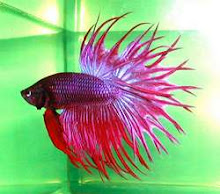First things first, your pair needs to be pampered for around 2 weeks to ensure they are at their optimum health. Treat them with IAL, live food such as bloodworm and immaculate water conditions in their 5 US Gallons (18.9L) tanks.

Female with horizontal bars
The next part of the process is to set up your 10 gallon tank. Add water but a maximum of only 4"-6" depth. Keep it bare-bottom, substrate would hide the eggs. Use the sponge filter, add a bushy plant (live plants work best to help keep the water healthier while the filter is off), some IAL, float the styrofoam cup securely in the tank. Make sure this tank has matured, in that there is as much good bacteria in the sponge filter as possible. Add the heater and set it to 80°F (26.7°C) .
Next, the male needs to be introduced to this tank. Add him slowly and carefully using the drip method (in a bag/cup, with tank water slowly dripped in for at least half an hour). Once he's in the tank, give him a day or so to get used to his surroundings.
Now it's time to introduce the female to him. She will need to be added to the glass chimney, so they can look, but not touch. The male will frolic and dance in front of the female, flaring and generally showing off. The female may or may not act receptive. She should be fairly eggy (fat with eggs) already, if not do not let her in with the male until she is. You will know she's ready for spawning if she's eggy and is showing vertical (not horizontal) bars. The male should be getting busy and building his bubble nest under the styrofoam cup, he will alternate between showing off and building his nest.





















































